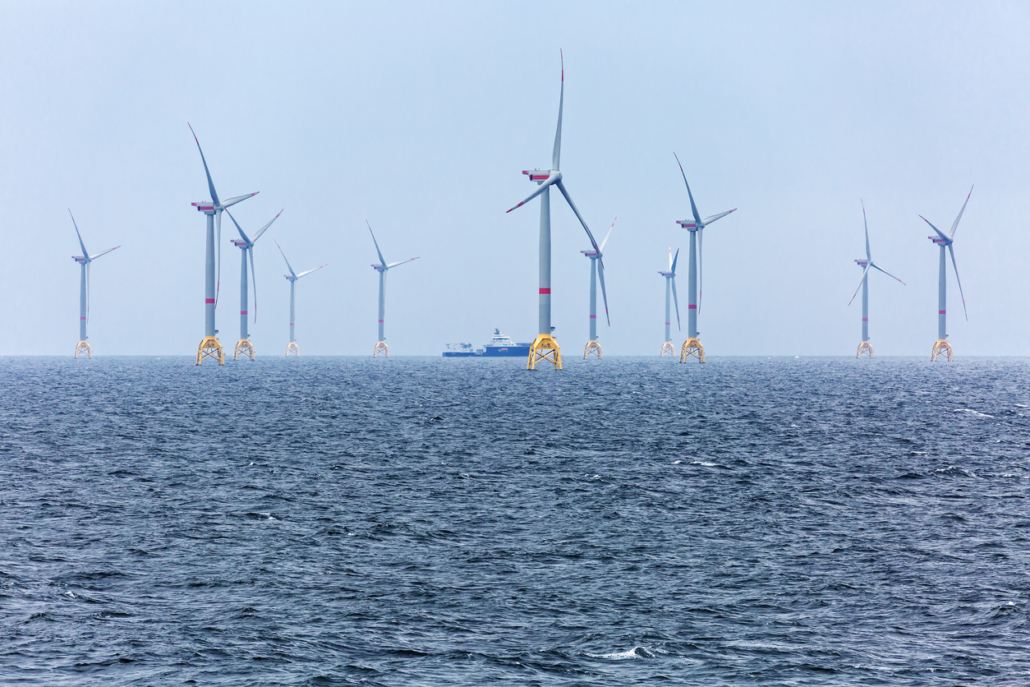The Importance of Scour Protection for Offshore Wind Farms

Offshore wind farms—the first of which was constructed in Denmark back in 1991—continue to dramatically increase in number and geographic extent. By 2050, it’s estimated that global offshore wind energy capacity will hit 1550 Gigawatts.
Turbines placed offshore tap into the generally stronger and steadier winds found out to sea, where airstreams encounter less frictional drag and fewer vertical obstructions compared with terrestrial settings. They also can be appealing given they’re less controversial in terms of siting, there are fewer issues over property rights and visually impacted sightlines, and because they can be situated close to big—and electricity-hungry—coastal cities.
The majority of offshore wind-turbine foundations are of the monopile design: a base formed by a single column. Monopiles in particular are vulnerable to the erosive process of scour, which can impact turbine operations, diminish functional lifespans, and even, in extreme cases, threaten to topple turbine structures.
Fortunately, seabed scour is very much among the phenomena that can be remedied and combated by innovative HYDROTEX fabric formworks from Synthetex. Our HYDROTEX solutions offer many competitive advantages for offshore wind farms as compared to traditional scour-protection systems such as riprap or packed rocks.
How Scour Impacts Offshore Wind Turbines
Scour refers to the removal of seabed (or lakebed) sediment or other material by the action of currents and waves. Encountering a monopile foundation, flowing water—whether driven by currents, waves, or both—speeds up and swirls around the structure with a vortex action. This removes sediment around the foundation structure, forming a scour hole. In the case of current action, the slowed water on the opposite side results in deposition of suspended sediment there, which can form a mound “downstream” of the scour hole. Additionally, associated submarine cables required for the wind turbines may need protection from similar erosive forces on the seabed.
Because monopiles support turbines through lateral transfer of load, the formation of a scour hole can compromise stability. It also impacts the natural frequency of the turbine structure, which must be carefully calibrated with wave, wind, and turbine action. Because it effectively lengthens the monopile, a scour hole makes it more flexible, enhancing structural fatigue and potentially shortening the turbine’s lifespan.
Dealing With Scour
Designers may plan for the impacts of scour over time by installing a longer foundation pile, and/or install systems designed to mitigate scour. Such armoring systems may include riprap and other rock dumping, rocks packed into flexible containers, precast concrete mattresses, and geotextiles.
The Advantages of HYDROTEX Products in Offshore Wind Turbine Scour Protection
Compared with riprap or pre-cast concrete, the HYDROTEX fabric formworks we offer here at Synthetex offer numerous advantages when it comes to protecting offshore wind turbine foundations from scour and their submarine cables from erosion. Because they’re arranged on the site unfilled before being pumped in situ or on a barge or ship deck with fine aggregate concrete, our underwater-ready HYDROTEX mattresses, grout bags, subsea fabric formworks and other products are much easier to transport and install, and they conform to the subgrade or seabed. They can be positioned and filled from the ocean surface or, at greater depths, by divers or ROVs.
The ease and versatility offered by HYDROTEX installation, and the dynamic, exact-fit armoring these fabriforms provide, make our Synthetex products ideal for scour protection in offshore wind farms. Among the specific HYDROTEX products that may be used for such applications include:
Our Synthetex team of engineers and installation specialists will work closely with you to select the perfect HYDROTEX solution for your offshore wind turbine and submarine cable scour-protection needs. Besides all of the assistance we offer ahead of installation, our engineers and installation support technicians can provide on-site technical support as well.
Contact Synthetex for More Information on How HYDROTEX Can Protect Offshore Wind Turbines From Scour
Don’t hesitate to reach out to our team for more details on HYDROTEX scour protection in the context of offshore wind farms. For a free consultation or project estimate, give us a call at 1-800-253-0561 or 770-399-5051 or write to us online at the Synthetex website.
